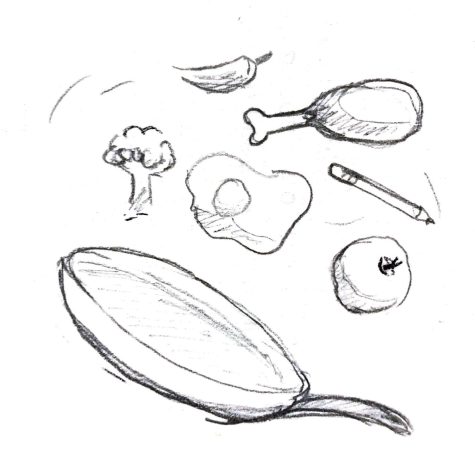Stirring the pot: The importance of cooking education in the nutrition unit
March 5, 2023
For a few weeks after the nutrition unit, my hand would freeze up as I preheated the oven for frozen pizza, or when I went to pour myself a glass of Martinelli’s. These were foods which I could consume without any preparation or thought; as someone who has grown up with microwave meals and frozen foods, these were the foods that I knew how to eat. I felt the sudden knowledge of the origin of these seemingly innocuous foods to be stifling: the factory production that went into making the pizza that shape, the fat in the cheese and the undoubtedly high levels of sugar in the juice. But I ate the pizza and drank the Martinelli’s with a sense of guilt and an inability to articulate what I should have been doing better with what I had.
In the nutrition unit in physical education (PE), we discussed the intricacies of proteins and where they’re found, about a balanced diet and how to achieve it. Yet, alongside that array of information lies a more sinister reality: the demonization of fast and processed food, with the presentation of few alternatives. One day we learned about the importance of consuming enough vitamins; the next we watched a documentary, “Fed Up,” about the horrors of McDonald’s. This juxtaposition, of the science of nutrition and the ugly facts of the American diet, left me feeling helpless. I’d learned in graphic detail the things that the wrong types of food could do to my body, and yet I had no clue what I should have been doing better. The nutrition unit should place a greater emphasis on how to make healthy meals and how to cook.
For many, processed food — whether it be frozen or fast — can feel like the only option. It’s quick, easy and inexpensive. Never has the American meal been prepared so far from our kitchens; since 2003, the amount of money Americans spend on food “away from home” has increased by 94 percent. We have become increasingly unable to cook for ourselves and increasingly reliant on a supermarket or a McDonald’s to do the heavy lifting of food preparation for us. Additionally, in a survey conducted by University of California (UC), Berkeley, time and cost were the most common reasons why college students said they avoided cooking and chose instead to eat pre-prepared meals.
Cooking, however, is often less expensive and less time-consuming than eating out. Beth Moncel, the founder of the website, Budgetbytes, dedicated to promoting healthy and inexpensive meals, spoke to this misconception.
“Making really simple and delicious food is less expensive per-serving than fast food,” Moncel said. “You can still make food that’s really delicious and satisfying in 30 minutes, and if you think about how much time it would take you to go drive to the drive-thru, sit in the line and wait for your food, a lot of times that’s close to a half hour.”

Nutrition and a knowledge of cooking go hand-in-hand. In a study conducted by UC Berkeley, following a college nutrition and cooking class, students cooked more frequently and skipped meals less. By teaching students how to cook under time constraints and with household items, the nutrition unit will leave students equipped to make better decisions about food. A key aspect of cooking is knowing what ingredients you’re consuming, a knowledge that is surrendered the second you bite into pre-prepared food.
Moncel describes a similar sentiment.
“You’re in control … [not only] of your budget, but you’re in control of your health,” Moncel said.
There are certainly ample resources to teach students how to make a healthy meal. Videos and information abound, such as the government-sponsored MyPlate infographic and sites like Moncel’s, detailing the different meal options based upon a single egg. Thus, the class time spent in my P.E. class watching “Fed Up” could have been spent teaching us how to cook better with the food that’s already in our homes. It is easy to understand how harmful fast food is. But it takes far more effort to learn what goes into a healthy meal.
This is not to say that the nutrition unit’s education about the negative effects of certain foods has no place in the curriculum. Learning how to eat healthy on our own terms is essential as we grow up and go on to make our own meals, independent of whatever foods are typically stocked in our Larkspur pantries. It is precisely the importance of nutrition education that makes learning how to cook in the PE unit so essential. Cooking lessons don’t necessarily need to be hands-on, but rather can take the form of videos and other materials on preparing meals, such as the YouTube channel Epicurious or the MyPlate infographic. Even simply discussing cooking in class can be helpful in this venture: What ingredients can you incorporate in a basic stir-fry? How can you make a meal out of yogurt and fruit?
In principle, it’s easy to eat unprocessed foods. Sure, carrots and eggs all day. But to actually make meals from these foods requires a degree of involvement many students often aren’t willing to commit. All students, one way or another, will make decisions to eat for themselves. But it is the nutrition unit that decides whether this will be a liberating experience or a binding one. It is in learning how to cook that we can leave the nutrition unit prepared to make our own nutritional decisions, rather than leaving much the same way we entered — reliant on fast food companies or unrealistic diets to keep us fueled.
The lack of cooking instruction in the nutrition unit renders the contents of the unit almost useless. School should be what bridges the gap in our nutritional education, not the source of that gap itself. What’s the relevance of knowing that the food you’re eating is bad if you don’t know how to eat any better? The presentation of cooking education and nutritional advice is key to the strength of the nutrition unit and to our own physical health — in a way that feels applicable outside of the dim lighting and cramped desks of the PE classroom, in a way that allows us to stay healthy and happy long after the final bell rings.







